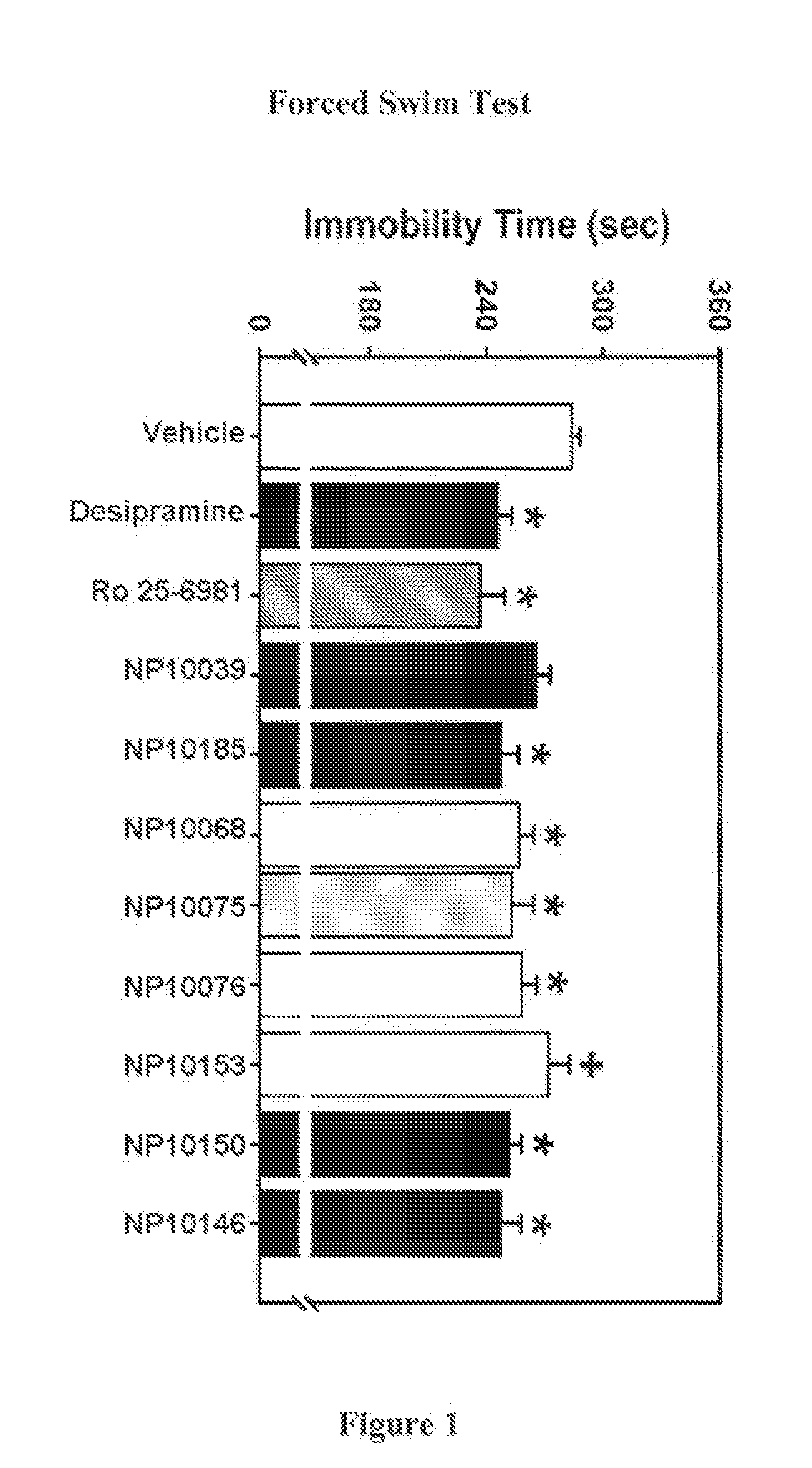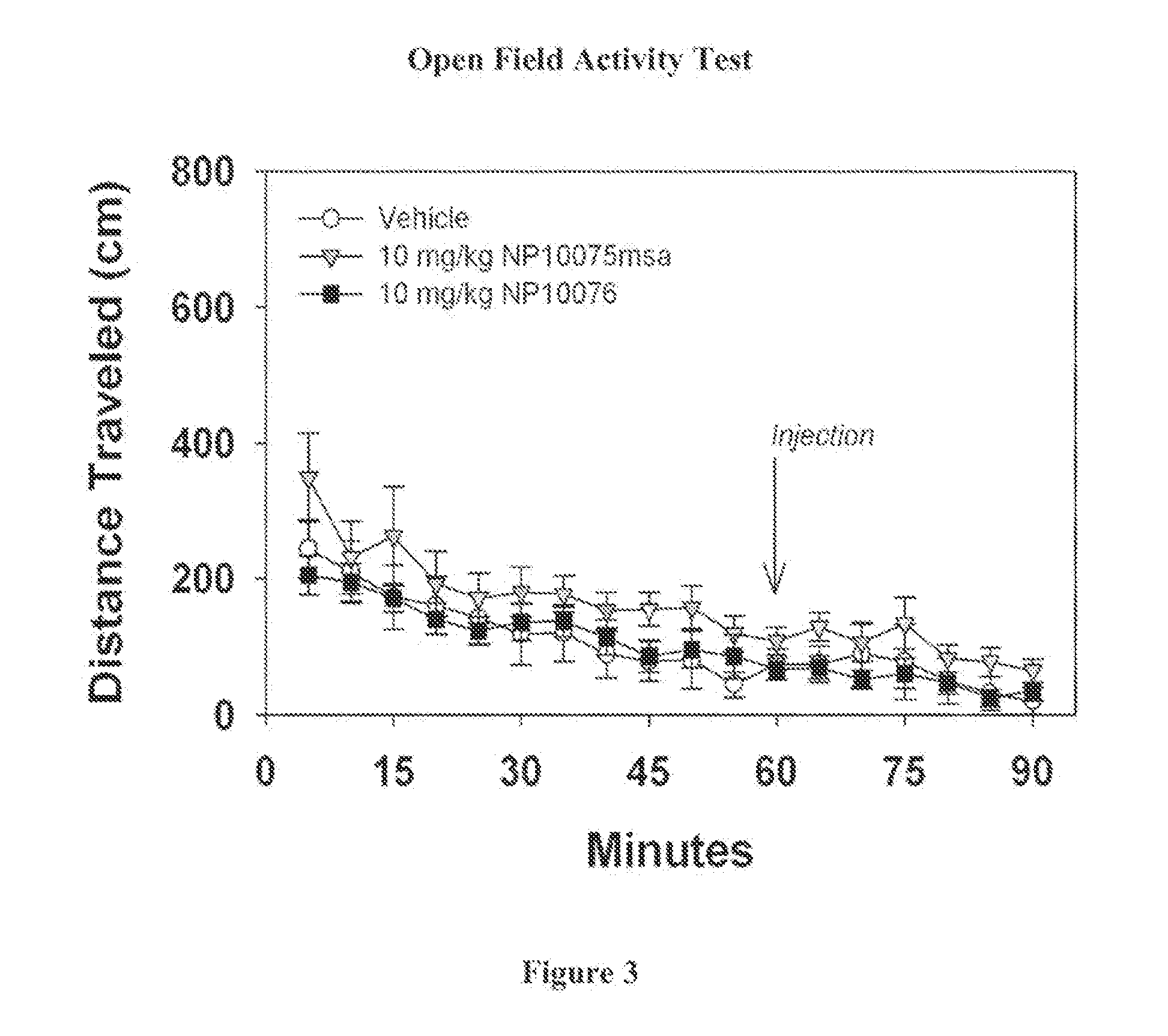NMDA Receptor Antagonists for the Treatment of Neuropsychiatric Disorders
a neuropsychiatric disorder and nmda receptor technology, applied in the direction of biocide, heterocyclic compound active ingredients, drug compositions, etc., can solve the problems of less prescription, side effects that can greatly influence the overall outcome of therapy, and many psychiatric diseases remain untreated or inadequately treated with current pharmaceutical agents, etc., to achieve increased pulse, decreased blood pressure, and increased blood pressure
- Summary
- Abstract
- Description
- Claims
- Application Information
AI Technical Summary
Benefits of technology
Problems solved by technology
Method used
Image
Examples
examples
[0340]The following examples are provided to illustrate the present invention and are not intended to limit the scope thereof. Those skilled in the art will readily understand that kown variations of the conditions and processes of the following preparative procedures can be used to manufacture the desired compounds. The materials required for the embodiments and the examples are known in the literature, readily commercially available, or can be made by known methods from the known starting materials by those skilled in the art.
Synthesis of Compounds
[0341]The compounds for use in the methods described herein can be prepared by any methods known in the art, such as in accordance with the methods and general synthetic strategies provided in WO 02 / 072542 or WO 09 / 006,437, or by the following synthetic methods, or variations of those procedures readily understand to those skilled in the art.
examples 1 and 2
N-(4-{3-[4-(3,4-Difluoro-phenyl)-piperazin-1-yl]-2-(S)-hydroxy-propoxy}-phenyl)-methanesulfonamide (Compound 1) and N-(4-{3-[2-(3,4-Dichloro-phenylamino)-ethylamino]-2-(S)-hydroxy-propoxy}phenyl)-methanesulfonamide (Compound 2).
[0342]
Step (i). 3-(4-Nitro-phenoxy)-2-(S)-propyleneoxide (i-1). 4-Nitrophenol (6.6 mmol) was dissolved in 5 ml anhydrous DMF. Cesium fluoride (19.9 mmol) was added to the reaction. The reaction mixture was stirred for 1 hour at room temperature and (S)-Glycidyl nosylate (6.6 mmol) was added to the reaction mixture. The reaction stirred for 24 hours at room temperature. Water (150 mL) was added and the solution was extracted with ethyl acetate. The organic phase was dried over MgSO4 and evaporated. The residue was purified with column chromatograph using ethylacetate: hexane (50:50) solvent system to give the desired product i-1 This step can be substituted with (R)-Glycidyl nosylate to get the R isomer.
Step (ii). 3-(4-Amino-phenoxy)-2-(S)-propyleneoxide (i-2)...
example 3
6-{3-[4-(4-Chloro-phenyl)-piperazin-1-yl]-2-(S)-hydroxy-propoxy}-3H-benzooxazol-2-one (Compound 3)
[0343]
Step (i). 6-(2-(S)-Oxiranylmethoxy)-3H-benzooxazol-2-one (ii-1). 5-hydroxy-benzoxazole (310 mg) and cesium carbonate (780 mg) were combined in 6 mL of N,N-dimethylformamide. The reaction was stirred for room temperature for 1 hour. (S)-glycidal nosylate (520 mg) was added, and the reaction stirred at room temperature overnight. The reaction was quenched with NH4Cl(aq) solution and extracted with ethyl acetate. The organic layer was washed with NH4Cl(aq) and NaCl(aq) solutions, separated, and dried over Na2SO4(s). Filtration and solvent removal was followed by absorption onto silica gel. Elution with an ethyl actate / methanol mixture (4:1) followed by solvent removal gave 445 mg of a yellow, oily solid.
Step (ii). 6-{3-[4-(4-Chloro-phenyl)-piperazin-1-yl]-2-(S)-hydroxy-propoxy}-3H-benzooxazol-2-one (Compound 3). To a solution of 300 mg of epoxide (ii-1) in 10 mL of absolute ethanol w...
PUM
| Property | Measurement | Unit |
|---|---|---|
| pH | aaaaa | aaaaa |
| enantiomeric excess | aaaaa | aaaaa |
| enantiomeric excess | aaaaa | aaaaa |
Abstract
Description
Claims
Application Information
 Login to View More
Login to View More - R&D
- Intellectual Property
- Life Sciences
- Materials
- Tech Scout
- Unparalleled Data Quality
- Higher Quality Content
- 60% Fewer Hallucinations
Browse by: Latest US Patents, China's latest patents, Technical Efficacy Thesaurus, Application Domain, Technology Topic, Popular Technical Reports.
© 2025 PatSnap. All rights reserved.Legal|Privacy policy|Modern Slavery Act Transparency Statement|Sitemap|About US| Contact US: help@patsnap.com



